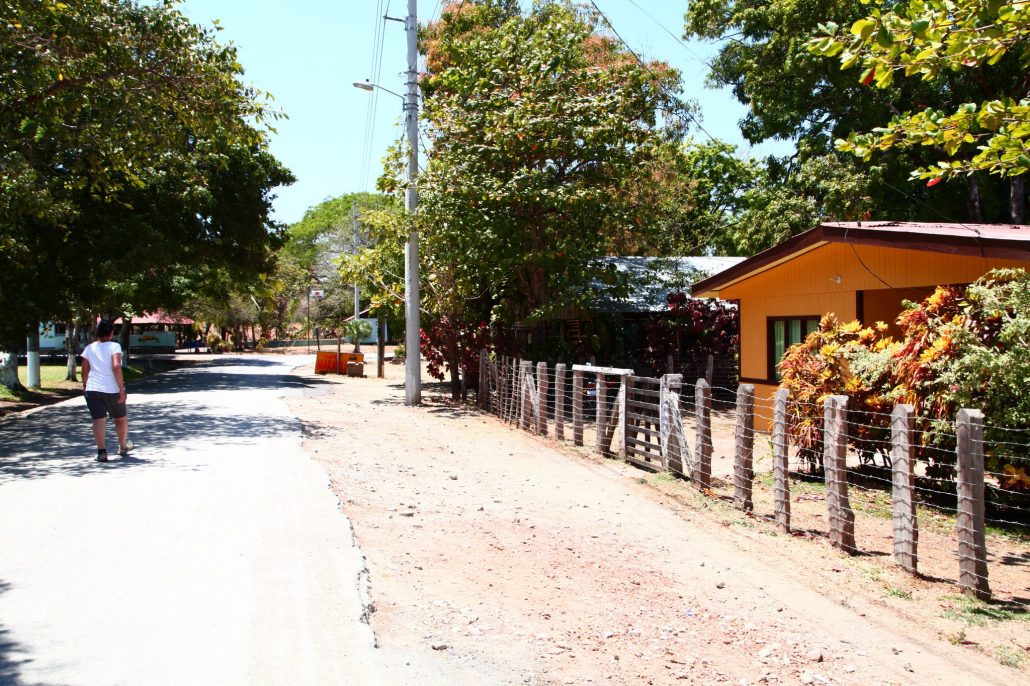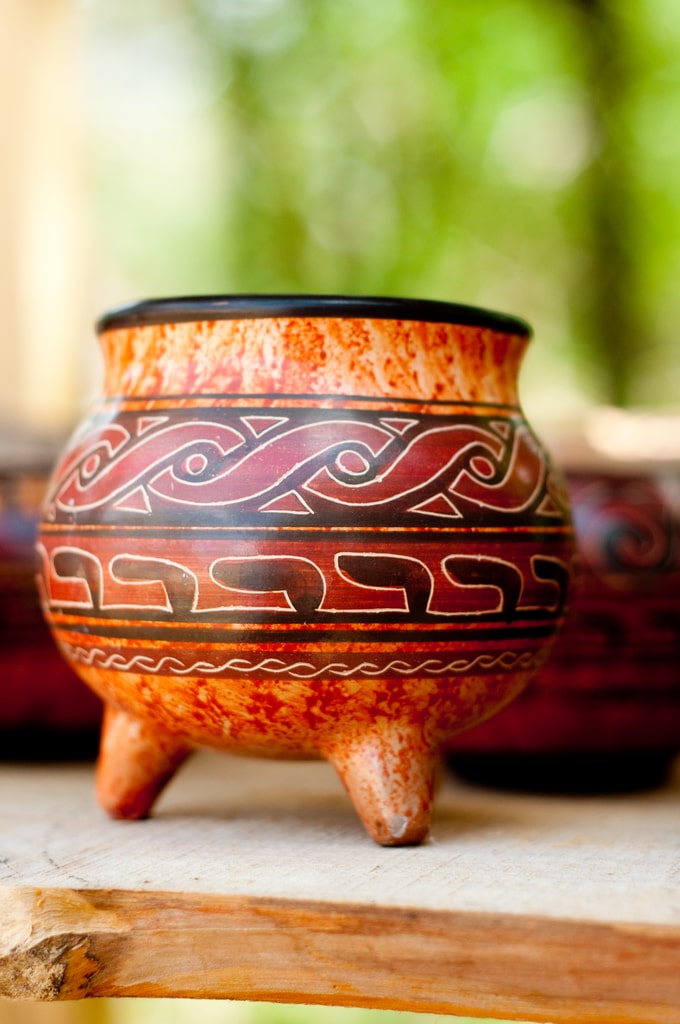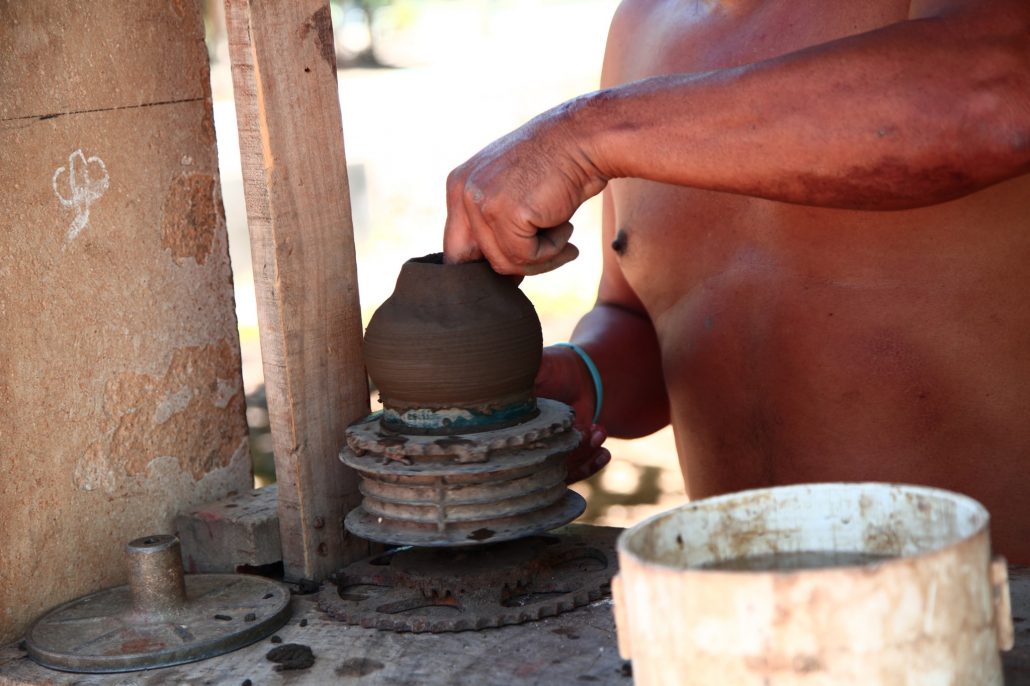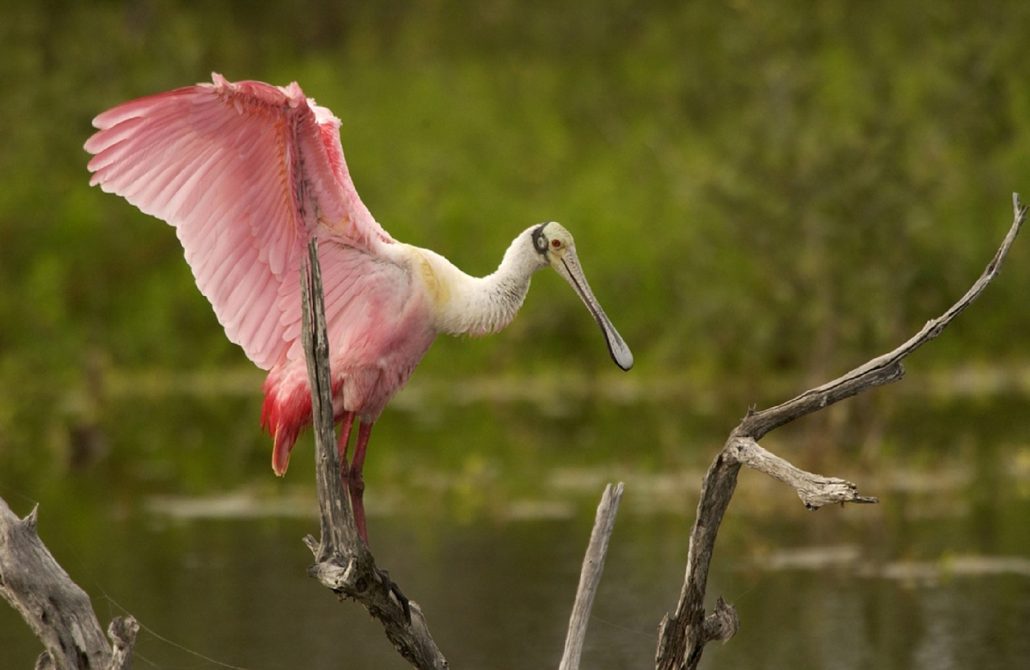Guaitil – pronounced, more or less, wy-teel – is the Costa Rica you've probably never heard of. And yet, you should have. Everyone should have. Because Guaitil is one of those special kinds of places that you cannot experience anywhere else.
This is your invitation to step back into a thousand years of tradition, to experience the Costa Rica of another millennia – before the conquistadors, before modernization, before Costa Rica even was Costa Rica. Guaitil is living, breathing history.
Guaitil is a Chorotega indigenous village, named for the dye-giving Guaitil tree and situated in Guanacaste and less than an hour from Tamarindo. It is a complete escape from the norm and exploration of tradition – a dusty, rugged town known best for its pottery. And, in our opinion, just as deservingly for its food. But we'll get there in a moment.

The tiny village of Guaitil is far off tourist trail and, even, off the beaten path for Costa Ricans. Not because it's a hard drive or a long drive, but simply for the fact that Guaitil flies under the radar. This is not your average day trip. We stated above that Guaitil is living history, but why? For one overarching reason: This village has preserved the legacy of Chorotega pottery, through the generations and over the centuries. Today, Guaitil's artisans still use the same methods, the same traditions, the same knowledge their grandparents and grandparents' grandparents used to craft their famous pottery. Generation after generation, the families of Guaitil have passed down their expertise – an expertise crafted and honed in pre-Columbian Latin America. An expertise that has long stood as the symbol of Chorotegan culture. Indeed, if you have the opportunity to visit any of Costa Rica's national history museums, you'll come upon artifact after artifact of Chorotega pottery: carefully crafted bowls and water jugs, jars and plates. Today, the people of Guaitil often produce exact replicas of these museum pieces – the government provides Guaitil artisans with detailed photographs of each, to ensure historical accuracy – offering visitors a chance to take home the almost-genuine artifact (literally). Quick note : Speaking of museums, if you're a pottery or local history buff, you might want to take a pass at the Chorotega Ceramic Ecomuseum in San Vicente. It's full of Chorotega pottery and the history of Guaitil, and also offers informative talks, pottery demonstrations, workshops, and more.
Today, Guaitil is a bit of a living museum: Small, artisan shops line the streets, displaying their wares for all to see. Here, hanging from twists of natural rope and sitting atop handmade displays, Guaitil pottery – plates and cups, pitchers and jars, and everything else in between – anchors the town to the past, while fueling its economy into the present. Here, everything is still handmade, from start to finish. And when we say everything, we do mean everything: From the clay they source from the ground, to the natural dyes the extract from Mother Nature, Guaitil's talented potters would be at home in 1000 CE as they are in 2000 CE. If you visit, you'll see firsthand how it works but, for the uninitiated: The Chorotega pottery process begins with natural clay and rock, which is combined to create a strong finished product. From there, natural paints – again, crafted with dyes sources from the earth – are added to create meaningful designs and then, the final product is polished from Guanacaste's raw materials: sand, stone, and rock. It's the potter's version of farm-to-table cuisine, only this time, it's earth-to-table. Every, single component you see throughout the process has been sourced from the area and handcrafted by Guaitil artisans. Every etching tool, every grinding stone, every pottery wheel, every paint pot – they are all made right here. What's more, no chemicals or preservatives are used in the process. The only thing to distinguish today's artisans from the ones who toiled centuries ago? A bit of innovation, usually in the form of recycled electronics to power an oven, a fan, or other modern tool. It's not that they can't do it the old way; it's just that the Chorotega are adaptable. They have a well-developed sense of what innovations benefit them. And, all this? Well, this fascinating feast-for-the-eyes is the economic base for an entire community. These crafts sustain Guaitil – and its traditions. Beyond the learning experience, beyond the interest, beyond even the sheer ingenuity of these artisans, Guaitil serves a more practical, in-the-now purpose: This is the place to purchase one-of-a-kind souvenirs.
Stick around for awhile, and you'll soon hear Guanacaste (our province) referred to as the Chorotega region. And for great reason. So named for the original inhabitants of Guanacaste, our region has for thousands of years been home to the Chorotega, an indigenous groups whose name means, " people surrounded by enemies." Indeed. Driven by war out of Mexico, the Chorotega pushed south into to southern Central America, eventually settling in the lowland tropical forests and dry savannahs of what are now southern Nicaragua, into Liberia (the capital of Guanacaste), and the Nicoya Peninsula. At the time of Spanish conquest, they were the most technologically and culturally advanced tribe in today's Costa Rica. So, who were they? Well, the Chorotega spoke a form of Nahuatl, a Uto-Aztecan language from central Mexico. They were ruled by both elected officials and an honored council of elders, who would become famous chiefs: Curime, Diria, and Nicoya, among others. These are famous names not only in Costa Rica, but throughout the indigenous world. The Chorotega enjoyed an advanced culture, centered around towns that numbered up to 20,000 – a large number, for the times. These towns fanned out around a central plaza – much like today's Costa Rican towns – and were comprised of wood homes, rectangular in shape and topped by finely crafted straw roofs. They had an active and developed economy, which trafficked in not only trade but the sale of produce and products. Like other groups in the region, the Chorotega used the precious cacao (chocolate) bean as currency. Fun fact: Talented counterfeiters of the day emptied the cacao beans of their valuable innards, refilling them with dirt. Chorotegan culture was largely based in religion, with priests given great respect and rituals playing an important part of everyday life. Chorotegan priests not only performed religious rites and ceremonies, but mirrored other indigenous cultures in their understanding of astronomy and mathematics. Additionally, the Chorotega practiced human sacrifice (most often, of their enemies captured during battle) and ritual cannibalism. We know all this because the Chorotegas were also meticulous historians, recording their ways of life in deerskin books. Sadly, these books no longer exist but they did survive into the time of the Spanish slave-traders, who chronicled their conquests and re-recorded some of Chorotega history. The Chorotega were peace-seeking but also known as brave and fierce warriors. (See human sacrifice and cannibalism, above!) When the Spanish conquistadors invaded Costa Rica, the Chorotega were some of the hardest fighters, even recording victories against the better-armed Spanish. One of our favorite stories tells the tale of Biriteca, a female warrior who lead a woman battalion that defeated the Spanish in battle. Though the Spanish made their mark on the Chorotega, ultimately it was the slave trade the devastated their populations : Captured Chorotegans were enslaved and shipped off to Panama and Peru, to work in the gold mines. By the year 1000 AC, local populations were almost nil. And still, the Chorotega influence persists, not only in towns like Guaitil but throughout Costa Rica. Even our very name – Guanacaste, the Chorotega name for the "ear tree" that you see throughout the province – reflects the stamp the Chorotega have had and still have on life here, in Costa Rica's northwest.
Okay okay, so your appetite is whet and you're ready to dive into a local history lesson-turned-Tamarindo day trip expedition. We're with you. To make the most of your limited time, the most popular way to see Guaitil is on a combined trip to Palo Verde National Park. To where, you ask? While not one of Costa Rica's most famous parks, it's one of our favorites – if you love wildlife, that is! Standing as one of Costa Rica's greatest contrasts, spectacular Palo Verde National Park is an example of living (and flourishing) in opposition: The park houses both vibrant wetland habitats and one of the world's most famed tropical dry forests. It's a contrast that works, beautifully well. The Rio Tempisque, or Tempisque River, feeds Palo Verde, sending its live-giving waters into an otherwise arid region. The result is not only spectacularly beautiful – sunbaked ground and parched dry forest, unrolling over thirsty limestone and then, the rush of a river and its drenched habitats – but also biologically fulfilling. And by that, we mean 45,000 acres and 15 distinct habitats, home to lagoons and marshes, deciduous forests and plains, limestone hills and riverside forests, wooded savannahs and saltwater mangroves, and many others. And this all brings us to the main attraction: the wildlife! This incredible – and, coincidentally, incredibly dense – biodiversity means that Palo Verde is a veritable oasis for local and migratory wildlife, especially during Guanacaste's extended (and, often, very dry) summers. These marshy riverbanks are life-giving, as evidenced by the more than 300 bird species, including the greatest concentration of shorebirds and waterfowl in Central America, that make their home here. Get your cameras and bird-spotting eyes ready, because Palo Verde can host up to 250,000 birds at any one time. That's a quarter-million birds, all living in one national park. And, that's the reason why we love you so, Palo Verde! It's also why we recommend pairing a Palo Verde boat tour with a visit to Guaitil, which is on the way (or the way back) from the park. Like wine and cheese – or corn and cacao, in our case – this is a perfect pairing!
Welcome to Costa Rican History

The tiny village of Guaitil is far off tourist trail and, even, off the beaten path for Costa Ricans. Not because it's a hard drive or a long drive, but simply for the fact that Guaitil flies under the radar. This is not your average day trip. We stated above that Guaitil is living history, but why? For one overarching reason: This village has preserved the legacy of Chorotega pottery, through the generations and over the centuries. Today, Guaitil's artisans still use the same methods, the same traditions, the same knowledge their grandparents and grandparents' grandparents used to craft their famous pottery. Generation after generation, the families of Guaitil have passed down their expertise – an expertise crafted and honed in pre-Columbian Latin America. An expertise that has long stood as the symbol of Chorotegan culture. Indeed, if you have the opportunity to visit any of Costa Rica's national history museums, you'll come upon artifact after artifact of Chorotega pottery: carefully crafted bowls and water jugs, jars and plates. Today, the people of Guaitil often produce exact replicas of these museum pieces – the government provides Guaitil artisans with detailed photographs of each, to ensure historical accuracy – offering visitors a chance to take home the almost-genuine artifact (literally). Quick note : Speaking of museums, if you're a pottery or local history buff, you might want to take a pass at the Chorotega Ceramic Ecomuseum in San Vicente. It's full of Chorotega pottery and the history of Guaitil, and also offers informative talks, pottery demonstrations, workshops, and more.
Welcome to Guaitil

Today, Guaitil is a bit of a living museum: Small, artisan shops line the streets, displaying their wares for all to see. Here, hanging from twists of natural rope and sitting atop handmade displays, Guaitil pottery – plates and cups, pitchers and jars, and everything else in between – anchors the town to the past, while fueling its economy into the present. Here, everything is still handmade, from start to finish. And when we say everything, we do mean everything: From the clay they source from the ground, to the natural dyes the extract from Mother Nature, Guaitil's talented potters would be at home in 1000 CE as they are in 2000 CE. If you visit, you'll see firsthand how it works but, for the uninitiated: The Chorotega pottery process begins with natural clay and rock, which is combined to create a strong finished product. From there, natural paints – again, crafted with dyes sources from the earth – are added to create meaningful designs and then, the final product is polished from Guanacaste's raw materials: sand, stone, and rock. It's the potter's version of farm-to-table cuisine, only this time, it's earth-to-table. Every, single component you see throughout the process has been sourced from the area and handcrafted by Guaitil artisans. Every etching tool, every grinding stone, every pottery wheel, every paint pot – they are all made right here. What's more, no chemicals or preservatives are used in the process. The only thing to distinguish today's artisans from the ones who toiled centuries ago? A bit of innovation, usually in the form of recycled electronics to power an oven, a fan, or other modern tool. It's not that they can't do it the old way; it's just that the Chorotega are adaptable. They have a well-developed sense of what innovations benefit them. And, all this? Well, this fascinating feast-for-the-eyes is the economic base for an entire community. These crafts sustain Guaitil – and its traditions. Beyond the learning experience, beyond the interest, beyond even the sheer ingenuity of these artisans, Guaitil serves a more practical, in-the-now purpose: This is the place to purchase one-of-a-kind souvenirs.
Guaitil: A Sampling of Millennia-Old Cuisine
After your shopping, we also encourage you to stop by one of the local restaurants, where you can sample local Costa Rican and traditional Chorotega fare. The Chorotega diet, which was primarily rooted in corn, has persisted over the centuries. Long after their populations were decimated from the slave-trade, the Chorotega still have great influence over the Guanacastecan diet, which pulls from the centuries to craft dozens of corn-based dishes, paired with beans, squash, fish, meat, and other local produce. Guaitil is known for this traditional fare and we strongly suggest you give it a sampling. It's delicious, healthy, and likely different from anything you've eaten before – not to mention, it's the local specialty!Guaitil and the Chorotega: A History

Stick around for awhile, and you'll soon hear Guanacaste (our province) referred to as the Chorotega region. And for great reason. So named for the original inhabitants of Guanacaste, our region has for thousands of years been home to the Chorotega, an indigenous groups whose name means, " people surrounded by enemies." Indeed. Driven by war out of Mexico, the Chorotega pushed south into to southern Central America, eventually settling in the lowland tropical forests and dry savannahs of what are now southern Nicaragua, into Liberia (the capital of Guanacaste), and the Nicoya Peninsula. At the time of Spanish conquest, they were the most technologically and culturally advanced tribe in today's Costa Rica. So, who were they? Well, the Chorotega spoke a form of Nahuatl, a Uto-Aztecan language from central Mexico. They were ruled by both elected officials and an honored council of elders, who would become famous chiefs: Curime, Diria, and Nicoya, among others. These are famous names not only in Costa Rica, but throughout the indigenous world. The Chorotega enjoyed an advanced culture, centered around towns that numbered up to 20,000 – a large number, for the times. These towns fanned out around a central plaza – much like today's Costa Rican towns – and were comprised of wood homes, rectangular in shape and topped by finely crafted straw roofs. They had an active and developed economy, which trafficked in not only trade but the sale of produce and products. Like other groups in the region, the Chorotega used the precious cacao (chocolate) bean as currency. Fun fact: Talented counterfeiters of the day emptied the cacao beans of their valuable innards, refilling them with dirt. Chorotegan culture was largely based in religion, with priests given great respect and rituals playing an important part of everyday life. Chorotegan priests not only performed religious rites and ceremonies, but mirrored other indigenous cultures in their understanding of astronomy and mathematics. Additionally, the Chorotega practiced human sacrifice (most often, of their enemies captured during battle) and ritual cannibalism. We know all this because the Chorotegas were also meticulous historians, recording their ways of life in deerskin books. Sadly, these books no longer exist but they did survive into the time of the Spanish slave-traders, who chronicled their conquests and re-recorded some of Chorotega history. The Chorotega were peace-seeking but also known as brave and fierce warriors. (See human sacrifice and cannibalism, above!) When the Spanish conquistadors invaded Costa Rica, the Chorotega were some of the hardest fighters, even recording victories against the better-armed Spanish. One of our favorite stories tells the tale of Biriteca, a female warrior who lead a woman battalion that defeated the Spanish in battle. Though the Spanish made their mark on the Chorotega, ultimately it was the slave trade the devastated their populations : Captured Chorotegans were enslaved and shipped off to Panama and Peru, to work in the gold mines. By the year 1000 AC, local populations were almost nil. And still, the Chorotega influence persists, not only in towns like Guaitil but throughout Costa Rica. Even our very name – Guanacaste, the Chorotega name for the "ear tree" that you see throughout the province – reflects the stamp the Chorotega have had and still have on life here, in Costa Rica's northwest.
Pair Guaitil with a Palo Verde Boat Tour

Okay okay, so your appetite is whet and you're ready to dive into a local history lesson-turned-Tamarindo day trip expedition. We're with you. To make the most of your limited time, the most popular way to see Guaitil is on a combined trip to Palo Verde National Park. To where, you ask? While not one of Costa Rica's most famous parks, it's one of our favorites – if you love wildlife, that is! Standing as one of Costa Rica's greatest contrasts, spectacular Palo Verde National Park is an example of living (and flourishing) in opposition: The park houses both vibrant wetland habitats and one of the world's most famed tropical dry forests. It's a contrast that works, beautifully well. The Rio Tempisque, or Tempisque River, feeds Palo Verde, sending its live-giving waters into an otherwise arid region. The result is not only spectacularly beautiful – sunbaked ground and parched dry forest, unrolling over thirsty limestone and then, the rush of a river and its drenched habitats – but also biologically fulfilling. And by that, we mean 45,000 acres and 15 distinct habitats, home to lagoons and marshes, deciduous forests and plains, limestone hills and riverside forests, wooded savannahs and saltwater mangroves, and many others. And this all brings us to the main attraction: the wildlife! This incredible – and, coincidentally, incredibly dense – biodiversity means that Palo Verde is a veritable oasis for local and migratory wildlife, especially during Guanacaste's extended (and, often, very dry) summers. These marshy riverbanks are life-giving, as evidenced by the more than 300 bird species, including the greatest concentration of shorebirds and waterfowl in Central America, that make their home here. Get your cameras and bird-spotting eyes ready, because Palo Verde can host up to 250,000 birds at any one time. That's a quarter-million birds, all living in one national park. And, that's the reason why we love you so, Palo Verde! It's also why we recommend pairing a Palo Verde boat tour with a visit to Guaitil, which is on the way (or the way back) from the park. Like wine and cheese – or corn and cacao, in our case – this is a perfect pairing!


